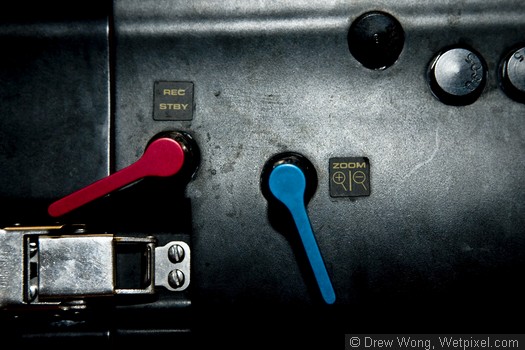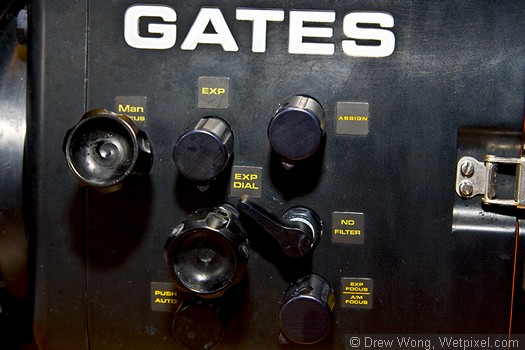Gates FX7/V1 housing for the Sony HDR-FX7 and HVR-V1U review
Please note that the notes in italic are the responses from John Ellerbrock, CEO of Gates. I thought it would be good to include the manufacturer’s responses to my review.
During last year’s DEMA, I’d spoken with John Ellerbrock at Gates about the Sony HVR-V1 housing and the possibility of testing the housing when it was available. It just so happened that I had two trips, a 17-day Banda Sea voyage and another 11-day Wakatobi reef monitoring trip planned for October, so John graciously sent his latest offering to me for testing, the Gates FX7/V1 underwater video housing. Included in the test was the Gates tripod (which was introduced at DEMA ’06) and the flat port. Unfortunately, the big Fathoms SWP44B lens was not available before my departure and I’d forgotten to request for the SP44 standard dome port. Thus, I could only concentrate on my tests on the handling and ergonomics of the housing and the new EM43 16:9 4.3” External Monitor. This housing also fits the HDR-FX7,
has been reintroduced as of Sep 2008 at US$1999. (updated 09-12-08)
The HousingThe FX7/V1 housing is made of machined marine grade anodized aluminum in a black finish. All the controls and locking mechanisms are stainless steel and the window ports are acrylic. It is approximately 370mm (depending on the port) x 230mm (no monitor attached) x 180mm (310mm with handles). It weighs approximately 9kg/20lbs with camera and the flat port.
The FX7/V1 housing has 14 mechanical controls giving the using access to 18 functions on the camera, plus full menu and picture profile controls. The left side of the housing has 10 controls: the Manual focus dial/knob, Exposure (manual/auto), Exposure Dial, Push Focus (AF onetime), Assign button, ND Filter and Expanded Focus/AF Auto/Manual in the front half. The rear left side resides the Picture Profile/Status, Shutter/Gain and White Balance/Menu knob controls. There is also an internal URPro flip filter. The right side of the housing has the REC and Zoom controls on the side and the Flip Filter lever in the front right side of the port.

Right: REC and ZOOM controls
The rear bulkhead has 3 acrylic windows with push/dial knob control for Sel (functions for menu and other controls) on the left side and the power dial on the right side of the bulkhead. The top window is the unmagnified viewfinder, which can accommodate the FX7 and V1 viewfinders (they are of different height).
(Drew—I’ll point out some things that you may want to consider including in the review. For example, the Push/SEL knob is an inventive piece of engineering. It looks deceptively simple but consider that one control provides reliable mechanical access to both rotate and push actions of the camera roller/SEL function. That said I note below that you had trouble with this control. I would have recommended a simple cleaning of the silicone rubber for grip to the camera wheel. That would have allowed perfect operation. I’ll be adding that to the manual.)

Left Front: EXP, EXP dial, AF/MF and Expanded Focus toggle, Focus dial, ND Filter, Assign controls
The front ports are bayonet 1/4-turn mounts with options for an acrylic flat port, SP44 dome port or the SWP44B Fathoms glass lens.
A few of the buttons served dual functions (e.g. Expanded Focus/AF), which means to switch between the two functions, one has to precisely turn and align the knob’s pin into preset holes for each function. This clever design allows for added functionality and minimum clutter. All knobs are spring controlled to prevent the buttons from sticking and thus keeping the camera from responding.
(The pin/hole is a feature for two reasons: 1) to prevent accidental activation as a ‘lock out’; and 2) to allow the control to activate 2 or more buttons by aligning the pin/hole for each. I note later in the review that it was troubling to make sure it was aligned but the alternative is more controls and unintentional activation.)
The housing can accommodate all Sony L series sizes including the big FP970, which allows for over 8 hours of operation.
The EM43 external monitor is basically a housed 16:9 LCD monitor with wet connectors. It runs on 8 AA batteries and has no controls on the outside of the monitor housing itself. There are image controls adjustable when the rear bulkhead is opened. The monitor has a base that allows it to slide into the top grove of the housing. This groove, like the handle grooves, run the entire length of the main housing, ending where the front and rear bulkheads are joined to the main body.
Inside, the camera tray is fastened to the housing by two screws, matched to a fixed bottom platform with matching holes for the screws. These two screws have o-rings to prevent them from dropping off. The bottom platform also has a frame in the front to ensure proper aligning of the camera inside the housing. This is especially important for a mechanical housing as the controls have to be able to reach the corresponding controls on the camera to work. The test housing only had the connectors for the monitor but there are options for a hydrophone, internal flip diopter and a wet alarm.
The housing comes with a four-leg rubber foot base that can be slid off as standard. There is also a removable 1.8kg ballast weight which is secured to the base by 4 screws.
The tripod is a mix of Ultralight Control Systems clamps and three sectioned aluminum extending arms controlled by two knobs on each arm. Two arms in the front and one pointing rear. The arms have a plastic ball foot.

The bottom of the housing with 1.8kg/4lbs ballast weight attached.